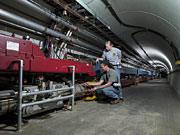- Number 348 |
- October 17, 2011
Fermilab says good-bye to Tevatron, focuses on the future

More than 1,400 physicists
received their Ph.D.s for
research with the Tevatron,
which was shut down on
Sept. 30 after 28 years of
operation.
More than ten thousand people from across the globe watched online to see the Tevatron particle accelerator at DOE’s Fermi National Accelerator Laboratory power down one final time. At the event on Sept. 30, thousands of collaborating scientists and employees celebrated nearly three decades of scientific and technological achievements that have changed the way we understand the world.
“The Tevatron exceeded every expectation ever set for it,” said Fermilab Director Pier Oddone during the shutdown ceremony. “The collider has reached peak luminosities that were considered totally impossible by scientists and engineers back in the eighties when the machine first came online.”
The Tevatron again and again did the impossible. It was the world’s first superconducting synchrotron. It required the development of the world’s most intense, consistent source of antiprotons. In the last several years, it operated 300 times beyond its original luminosity design capabilities, creating about 30 million proton-antiproton collisions per second.
The creativity and tools needed for these achievements helped enable consumer products, such as MRI machines, and helped create a globally competitive workforce that has gone on to help design the Large Hadron Collider and countless other physics experiments as well as improve industries as diverse as finance and manufacturing.
Shutting the Tevatron down was a bittersweet time for employees and collaborators, many of whom had spent most of their careers making the Tevatron one of the most productive sources of physics research in the world. The two collaborations of scientists who operated the CDF and DZero collider experiments will continue to churn out results from their Tevatron data at an average rate of one scientific paper a week for at least two more years.
"The Tevatron program has been remarkably successful; from the discovery of the top quark, to the precision measurement of the W boson mass, the observation of Bs mixing and the many limits set on potential new physics theories," said Rob Roser, co-spokesperson for CDF. "The Tevatron has changed the way the world views particle physics."
The discovery of the tau neutrino by the Tevatron’s fixed-target program has been a major achievement in neutrino physics worldwide. The precision measurements by CDF and DZero of the top quark and the W boson mass have laid the groundwork for the search for the elusive Higgs particle.
“This is one of the most challenging precision measurements at the Tevatron,” said DZero co-spokesperson Dmitri Denisov. “It took many years of efforts to collect and reconstruct the data and then perform the complex analysis to improve our knowledge of this fundamental parameter of the Standard Model.”
By the end of 2012, data from the Tevatron and the Large Hadron Collider will either lead to the discovery of the Higgs particle or rule out the particle’s existence. More than 900 scientists in the United States use Fermilab’s LHC Remote Operations Center and computing facilities to work on the CMS experiment at the LHC.
Fermilab, the only DOE national laboratory dedicated to particle physics, plans to build upon the pioneering spirit that built the world’s largest proton-antiproton accelerator to construct the Long-Baseline Neutrino Experiment and the world’s most powerful linear proton accelerator, the half-mile-long Project X. The accelerator would enable Fermilab to lead in a new era of particle physics, producing the largest number of particles to optimize the study of the rarest particle interactions.
The Project X research program would build on the neutrino, muon and kaon experiments already operating and planned for the next five to ten years. The Project X accelerator would tie into the laboratory’s existing accelerator complex. Following the Tevatron’s shutdown, Fermilab continues to operate most of the laboratory’s accelerators, and upgrades to several machines are under way.
"We will really miss the Tevatron but we have to move on and hopefully do something even better, contributing to pushing back the frontiers of science," said Roger Dixon, head of the Accelerator Division.
Submitted by DOE’s Fermi National Accelerator Laboratory
